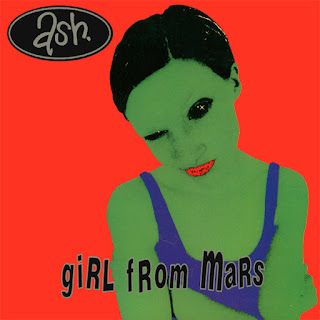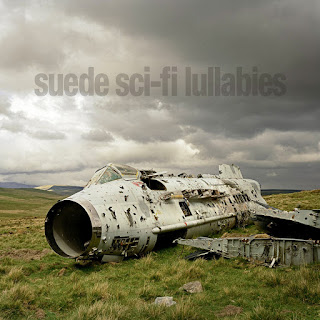Whilst researching the various SF-related 90s topics which have informed recent posts, I began to explore the connections with one of my formative influences of the decade: Indie Rock. As a fan of all things ‘indie’ around the first half of the 90s (when I was a late-teenager and student), I had various memories and favourites from the genre’s heyday in that pre-Internet age. The affiliation is less immediate than with the ambient and rave scenes of the era, but various connections can be found.
The associated English artists Spacemen 3, Sonic Boom/Spectrum, and Spiritualized (the best-known/most commercially successful of the trio) all explored otherworldly imagery and themes, often pharmacologically inspired. The Spiritualized albums Lazer Guided Melodies (1992) and especially Ladies and Gentlemen We Are Now Floating in Space (1997) epitomise these qualities. Among their contemporaries categorised as ‘shoegazers’, the band Slowdive ventured into similar territory with their second album, 1993’s Souvlaki, including collaborations with Brian Eno and the ambient-inspired ‘Souvlaki Space Station’.
Stereolab, with French vocalist Laetitia Sadier, offered a combination of easy-listening sensibilities and avant-pop epitomised in the 1993 EP Space Age Batchelor Pad Music – a nod to the hi-fi test records and ‘space age pop’ of an earlier era. The following year’s Mars Audiac Quintet expanded on the formula, with ‘The Stars Our Destination’ a reference to Alfred Bester’s 1956 novel (itself seen as a precursor of Cyberpunk). Meanwhile ‘International Colouring Contest’ was a tribute to outsider musician Lucia Pamela, whose 1969 album Into Outer Space reports a trip to the moon.
 Northern Irish band Ash kicked off a series of successful singles with 1995’s ‘Girl from Mars’, and a later compilation, Intergalactic Sonic 7″s, reinforced their sci-fi influences. Less likely artists also touched on sf themes; the title and artwork of Suede’s B-sides collection, Sci-Fi Lullabies (lifted from an earlier lyric). A song by Swedish outfit the Cardigans, ‘Daddy’s car’, imagines a carefree European road trip turned cosmic: “From Luxembourg to Rome, From Berlin to the moon / From Paris to Lausanne, From Athens to the sun / Our car became a spacecraft, flashing through the world – Crashed down in Amsterdam.”
Northern Irish band Ash kicked off a series of successful singles with 1995’s ‘Girl from Mars’, and a later compilation, Intergalactic Sonic 7″s, reinforced their sci-fi influences. Less likely artists also touched on sf themes; the title and artwork of Suede’s B-sides collection, Sci-Fi Lullabies (lifted from an earlier lyric). A song by Swedish outfit the Cardigans, ‘Daddy’s car’, imagines a carefree European road trip turned cosmic: “From Luxembourg to Rome, From Berlin to the moon / From Paris to Lausanne, From Athens to the sun / Our car became a spacecraft, flashing through the world – Crashed down in Amsterdam.” The growth of US alternative/college rock music through the 1980s saw a spate of bands emerge in the Boston/Massachusetts area. Galaxie 500 produced a psychedelia-influenced sound with space-rock references. I continued to associate them with sci-fi even after discovering they were actually named after a car! Singer and lead guitarist Dean Wareham continued to explore this ‘dream pop’ territory with his next band, Luna, formed in 1991. The better-known Pixies also sprang from the Boston area, led by Black Francis and gaining acclaim by the late 80s for their combining an abrasive style with melody, and the quiet/loud dynamics which would influence Nirvana among others. Their early 90s albums Bossanova and Trompe le Monde saw Francis delve into sf-inspired lyrics, which developed further in his solo career as Frank Black. His 1997 album The Cult of Ray paid homage to writer Ray Bradbury (who Black also interviewed).
Finally, a song that stands alone: Pop Will Eat Itself’s ‘X, Y and Zee’, 1991’s slice of ‘intergalactic punk rock hip hop’. Singer Clint Mansell later became a film composer, with credits including the soundtrack to Moon, directed by Duncan Jones in 2009.
Ash, ‘Girl from Mars’ (1995): Design – Carnage; Other [Girl from Mars] – Sarah From Islington; Photography – Roger Sargent
Luna, Lunapark (1992): Art Direction – Laurie Henzel; Studio Photography – Macioce
Pixies, Bossanova (1990): Art Direction, Design – Vaughan Oliver / v23; Artwork [Globe] – Pirate Design; Photography – Simon Larbastier; Design Assistance – Chris Bigg
Sonic Boom, Spectrum (1990): Artwork [Commercial Art] – Sonic, T + CP London; Lacquer Cut By – Porky; Photography [Sonic] – Steve Double; Photography– Andy Earl
Spiritualized, Lazer Guided Melodies (1992): Original Artwork – Mr Ugly; Logo Design – Albert Tupelo; Design – Andrew Sutton for Blue Source; Model Maker – Gavin Lindsay; Photography – Pete Gardner
Stereolab, Space Age Bachelor Pad Music (1993): Design – Magic Glue
Stereolab, Mars Audiac Quintet (1994): Layout – Trouble; Photography – Peter Morris
Suede, Sci-Fi Lullabies (1997): Image ‘Hidden’ by John Kippin; Art Direction – Peter Saville; Design – Howard Wakefield








No comments:
Post a Comment